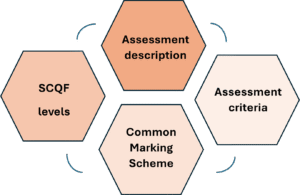
In this post, Elizabeth Stevenson explores the concept of assessment literacy, why it is useful for effective teaching practices, and how to develop assessment literacy through marking practices, dialogue and careful course design. Elizabeth is a Reader and Programme Director of two MSc Science Communication and Public Engagement programmes. This post is based on her presentation at the Learning and Teaching Conference, and is part of the ‘Transformative Assessment and Feedback’ Learning and Teaching Conference series.
Introduction
How many university teaching staff could give an ‘off the cuff’ presentation about assessment literacy right now? Probably not everyone. How many students are familiar with the term ‘assessment literacy’ and can use the ideas to guide their study, prepare their assignments, understand their marks and feedback and utilise marks and feedback effectively to develop their learning? Probably even fewer students. Is an explanation of assessment literacy an essential aspect of staff training and student induction? Not always.
My main point is that we need to be explicit about assessment literacy and intentional about developing capability within our teaching teams and with our students. If staff do not have a qualification for teaching in higher education and if the process of assessment has not been explicitly discussed with students, then it is less likely that they will develop assessment literacy simply through a process of ‘incidental osmosis’.
Assessment literacy
“Assessment literacy is the capability of staff and students to make sense of assessments and armed with this understanding, to exercise more control over teaching and learning” (Price et al., 2012).
While there are many descriptions of assessment literacy, Price et al. (2012) highlight the following aspects which encapsulate many aspects from other descriptions:
- connectedness of assessment and learning;
- assessment principles such as reliability and validity;
- assessment techniques and methods;
- assessment criteria, standards and policies;
- feedback purposes and processes.
In other words, the development of assessment literacy in staff will lead to more effective assessment design and more consistent marking. This leads to better course design, which ultimately leads to greater efficiency and enjoyment in the processes of teaching and assessment through understanding and mastery of the processes. For students, assessment literacy results in a more informed approach when preparing for assessment, with greater understanding of the assessment tasks and how they relate to learning from the course. Students learn how to use the assessment tasks to help structure their learning and therefore develop a more systematic approach to study, resulting in more confidence and autonomy in their learning.
Why is this useful for you?
If you are reading ‘Teaching Matters’, you may be thinking: ‘I know about assessment literacy, why is this useful to me?’ Perhaps you are a Course Organiser or Programme Director. Do you spend considerable amounts of time moderating, re-marking and addressing student concerns about marks and feedback? It may be useful to redirect this time into intentionally developing assessment literacy in your team.
Something which is often overlooked is that teaching in higher education is one of three domains (research, teaching and public engagement) in which an academic utilises their disciplinary expertise. Being an excellent researcher does not necessarily translate into being effective in teaching and/or public engagement (Stevenson and McArthur, 2015). This is about recognising and highlighting the fact that the application of disciplinary expertise will be different in a teaching and assessment context compared to a research context and will require the development of different capabilities in staff.
What can we do?
1. Marking and feedback
Take 10 minutes on Microsoft Teams with markers before marking takes place.

- Review the ‘critical connections’ with markers, i.e., how do the assessment criteria relate to the assessment description; how does this articulate to the Common Marking Scheme and SCQF level?
- Discuss what ‘Excellent’ (with respect to the Common Marking Scheme) looks like in the assignment.
- What are the key aspects to reward/penalise and why?
- What should be noted in feedback? (The extent to which students have done something well or badly and why). What can they do to improve?
Repeat the same process for exam questions and model answers. Discuss the different ways in which the questions can be answered correctly and reward appropriately.
These discussions about assessment and feedback help to build expertise about an academic discipline through the lens of assessment and feedback.
2. Assessment literacy for course design and development
Take time to think about the critical connections between various elements of a course and plan the assessment during the development of the course, not as an add-on at the end.

3. Importance of dialogue between staff
“Assessment is largely dependent upon professional judgement and confidence in such judgement requires the establishment of appropriate forums for the development and sharing of standards within and between disciplinary and professional communities”.
(HEA, 2012 p. 21)
Programme Directors and Course Organisers should build in time for these dialogues. For staff at School, College and University level, there needs to be explicit recognition in workload models and/or allocation of FTE that these discussions are essential to develop assessment literacy in staff. Afterall, more staff who have assessment literacy may help to address student perception about feedback!
4. Importance of dialogue between staff and students
From my experience as a lecturer, there are some students who do not read the Course Description; which is a little like trying to do a jigsaw puzzle without looking at the picture on the box. Discuss the Course Description and Learning Outcomes with students to assist them in situating themselves in the context and rationale of the course and therefore what the assessment is actually looking to assess.
Discuss the relationship between the assessment description and assessment criteria (Rust et al., 2003) with students. Also, discuss how the Common Marking Scheme articulates to the assessment criteria and highlight the requirements of the SCQF level of their course. Highlight to students how the assessment criteria can be used as guidance while developing their submission, and how they can be used as a way of checking whether the draft submission is meeting these criteria. These practices will develop autonomy in student learning
Be transparent about marking processes and about how feedback is produced, i.e., articulate the checks and balances in marking procedures. The aim is to give students confidence in assessment processes. Engage with students individually (if possible) and as a class about marks and feedback. Ensure both staff and students are aware of Taught Assessment Regulations and associated policies.
Conclusion
The intentional development of assessment literacy in both staff and students will result in more consistent marking and feedback, and better understanding of marks and feedback by students. Staff will develop a greater understanding of how all the elements of a course articulate together and therefore develop well designed courses. Students will develop a more systematic approach to their study and be able to use their feedback from assessment effectively. Overall, this will lead to greater confidence and efficiency. Time spent developing assessment literacy results in time saved elsewhere, and the teaching and learning experience will be more enjoyable and productive for everyone.
References
Biggs, J.B. (2003) Teaching for quality learning at university. Buckingham: Open University Press/Society for Research into Higher Education. (Second edition)
HEA (2016) A Marked Improvement [online] p.21. Available from https://s3.eu-west-2.amazonaws.com/assets.creode.advancehe-document-manager/documents/hea/private/a_marked_improvement_1568036814.pdf
Price, M., Rust, C., O’Donovan, B., Handley, K. and Bryant, R. (2012) Assessment Literacy: The foundation of improving student learning. (The Oxford Centre for Staff and Learning Development).p.10.
Rust, C., Price, M. and O’Donovan, B. (2003). Improving Students’ Learning by Developing their Understanding of Assessment Criteria and Processes. Assessment & Evaluation in Higher Education, 28(2), 147–164. https://doi-org.eux.idm.oclc.org/10.1080/02602930301671
Stevenson, E. and McArthur, J. (2015) Triple nexus: improving STEM teaching through a research-public engagement-teaching nexus, International Journal for Academic Development, 20:3, 291-294, DOI: 10.1080/1360144X.2014.995662
Elizabeth Stevenson is a Reader and Programme Director of two MSc Science Communication and Public Engagement programmes (full-time on-campus and part-time online). She is particularly interested in supporting students in their learning through developing their assessment literacy.


